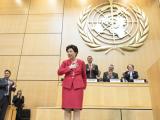Nov 20, 2009
Flu shows signs of peak in some regions
Signs of a peak in pandemic flu activity continue in several Northern Hemisphere locations, though transmission is still intensifying in Canada and northern and southern Europe, the World Health Organization (WHO) reported today. Sharp increases were noted in Kazakhstan and Israel; Colombia and Peru also reported increases. More than 99% of subtyped influenza A viruses in Europe are the pandemic strain, and a decreasing number of seasonal viruses are being detected in China and Southeast Asia.
http://www.who.int/csr/don/2009_11_20a/en/index.html
Nov 20 WHO pandemic update
APHA asks Obama to support CDC's N-95 stance
In a letter yesterday, the American Public Health Association (APHA) asked President Obama to resist efforts to change current CDC guidance on respiratory protection for healthcare workers caring for H1N1 patients, which emphasizes face-fitting N-95 respirators over surgical masks. The APHA said it "supports not only the current guidance," but the process by which the guidance was derived. This stance fits respiratory-protection language in a 2006 APHA policy statement on pandemic preparedness.
http://www.apha.org/NR/rdonlyres/31F910D4-3A1E-419E-A14B-9F43C2D7C776/0/APHAOHSH1N1respirators.pdf
Nov 19 APHA letter
Study spotlights asthma risk in kids
A study published in CMAJ (Canadian Medical Association Journal) found that asthma "appears to be a significant risk factor for severe disease" in children with H1N1 flu, according to the authors. In comparing 58 children hospitalized for H1N1 with 200 children admitted with seasonal flu, the authors found little difference in flu severity between the groups. But 22% of children admitted with H1N1 had asthma, compared with 6% of those admitted with seasonal flu.
http://www.cmaj.ca/cgi/content/abstract/cmaj.091724v1
Nov 19 CMAJ study abstract
Seasonal, H1N1 strains circulating in Oklahoma
Oklahoma has had its first seasonal flu-related death of the season, showing that the seasonal and pandemic strains are both circulating in the state, according to a report today by The Oklahoman newspaper. State epidemiologist Dr. Kristy Bradley said five more pandemic flu deaths were reported in the state in the past week, but flu activity is slowing, with fewer flu-related hospitalizations and doctor visits.
http://www.newsok.com/flu-strains-deaths-start-to-overlap-in-oklahoma/article/3418910
Nov 20 Oklahoman report
Glaxo recalls vaccine lot over allergic reactions
GlaxoSmithKline has withdrawn a 170,000-dose lot of H1N1 vaccine distributed in Canada because of an unusual number of allergic reactions, CTV News reported today. Health officials reported six anaphylactic reactions to doses from the lot, versus an expected rate of only one or two, the story said. The company asked provinces to set aside the doses so it can test them. Manitoba's chief medical officer of health said the reactions were brief and all the patients recovered.
http://www.ctv.ca/servlet/ArticleNews/story/CTVNews/20091119/Flu_Reaction_091119/20091120
Nov 20 CTV report
China responds to underreporting claim
After one of China's top flu researchers, Zhong Nanshan, said the country might be underreporting its pandemic flu deaths, the Chinese health ministry said today that anyone concealing H1N1 fatalities would be severely punished, Reuters reported. Earlier this month the ministry adopted a new policy that deaths in patients with confirmed H1N1 would be attributed to the virus, even if they had other conditions. Zhong had said some facilities weren't testing for H1N1 in severe pneumonia cases.
http://www.reuters.com/article/healthNews/idUSTRE5AI0NO20091120
Nov 20 Reuters story
EU regulators OK single vaccine dose for most
In a reversal of earlier advice, Europe's drug regulatory agency said today that a single dose of the approved adjuvanted H1N1 vaccines may be sufficient in most adults and older children. In October the agency had affirmed an earlier two-dose recommendation. But today regulators said a single dose can be used in adults between ages 18 and 60, and also in children from age 9 (for Focetria) or 10 (for Pandemrix). They said a single dose of Pandemrix is also sufficient for elderly people.


















